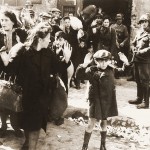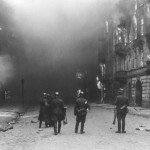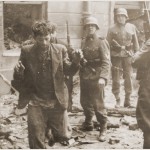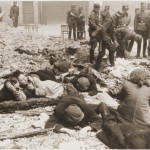70th Anniversary – “The Jewish Quarter of Warsaw is No More!”
In May 1943, a 75-page document called the “The Jewish Quarter of Warsaw is No More!” was given to SS Chief Heinrich Himmler. The official report, written by Jürgen Stroop, commander of the forces that liquidated the Warsaw Ghetto, chronicled the SS suppression of the April 1943 uprisings. Known commonly as “The Stroop Report,” the book has become one of the most important sources in determining the extent of the death and destruction at Warsaw.
The Stroop Report looked more like a family scrapbook than it did an official government document, filled with photographs with hand-written captions of the operation and bound in black leather. The craftsmanship and attention to detail reveal a great deal about how the persecution of Jews was viewed; Stroop was proud and saw the defeat of the Polish Resistance in Warsaw as a major milestone that he believed would be celebrated for years to come. The photographs of dead bodies, burning buildings and Jews being rounded up at gunpoint were images of a Nazi triumph. The text contains boasting of how many thousands of Jews perished and what weaponry and other supplies the SS managed to secure for themselves. In the first section, which contained all communiqués sent to SS Police Leader East Friedrich-Wilhelm Krüger, the burning of buildings to get Jews out is described in detail:
“Our setting the block on fire achieved the result in the course of the night that those Jews whom we had not been able to find despite all our search operations left their hideouts under the roofs, in the cellars, and elsewhere, and appeared at the outside of the buildings, trying to escape the flames. Masses of them- entire families-were already aflame and jumped from the windows or endeavored to let themselves down by means of sheets tied together or the like. Steps had been taken so that these Jews as well as the remaining ones were liquidated at once. During the whole night there were shots from buildings which were supposed to be evacuated. We had no losses in our cordoning forces. 5,300 Jews were caught for the evacuation and removed.”
Select Images from the Stroop Report:
Three copies of the Stroop Report were made, and today are housed in the National Archives in Washington D.C., the Institute of National Remembrance in Warsaw and the Bundesarchiv in Koblenz, Germany respectively. The report was used as one of the key pieces of evidence of war crimes during the Nuremberg Trials.
Stroop was captured in May 1945 in Bavaria. He was put on trial by the U.S. military Tribunal at Dachau, found guilty and sentenced to death, but was later extradited for trial in Poland before his execution was carried out. Throughout his imprisonment, Stroop remained proud of the destruction he oversaw, remembering the burning of Warsaw’s Great Synagogue as “a wonderful sight…an unforgettable allegory of the triumph over Jewry.” In 1951, the Polish court found him guilty and sentenced him to death. He was hanged outside the Mokotow prison in Warsaw, steps away from the former ghetto he destroyed.
More Resources:
Learn more at “The Holocaust at a Glance” and download a printable fact sheet.
Posted by Gemma Birnbaum, Digital Education Coordinator at The National WWII Museum.
- Posted :
- Post Category :
- Tags :
- Follow responses to this entry through the RSS 2.0 feed. You can skip to the end and leave a response. Pinging is currently not allowed.








Leave a Reply